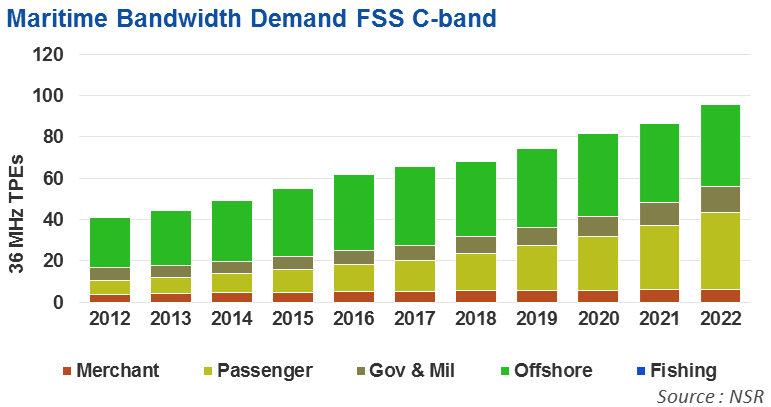Long Live C-band for Maritime!
Jan 20th, 2014
by Brad Grady, NSR
With many new HTS systems launching within the next 12 – 24
months, it is easy for classical FSS C-band capacity to get lost
in the mix. Yet, as NSR project’s in its Maritime
Satellite Markets report,
FSS C-band is not going anywhere –
adding another 55 TPEs of capacity over the next ten years.
Maritime service providers continue
to expand their FSS C-band capacity, as more end-users continue
to increase their bandwidth demands. Even KVH recently
announced a doubling of the capacity for two of the three global
C-band beams of its mini-VSAT Broadband network. Given
C-band’s near ubiquitous coverage for maritime markets (minus
the polar regions), high tolerance for rain-fade, and almost
8,000 In-service units by 2022,
FSS C-band still has a lot of momentum
within the marketplace.
But the real question remains: could there be an end in-sight
for FSS C-band for maritime markets?
In short, it is unlikely within even the next 15 years.
Even as GEO-HTS C-band based systems come online, their limited
coverage outside of major areas of maritime concentration (such
as Atlantic shipping routes or centers of Oil & Gas
concentration) continues to bolster support for the traditional
FSS C-band networks. Although merchant maritime traffic
will follow highly predictable routes between the major
land-masses, other maritime markets continue to roam the oceans
– from cruise ship routes opening up within the Pacific, new
areas of O&G activity, to ongoing military activities throughout
the high seas. These are all heavy users of FSS C-band
capacity and even with
the introduction of GEO-HTS and MEO-HTS, they will continue to
rely on FSS C-band.

Even merchant shipping – the largest market for maritime
satellite-based connectivity – will continue to lean on FSS
C-band capacity to enable highly robust network availability at
higher throughputs and better price-points than MSS-based
offerings can strictly provide. And,
robust network design continues to be
the significant factor in FSS C-band’s appeal.
However, some steady
migration of FSS C-band from primary to co-primary or secondary
roles will impact the per-unit revenue growth prospects
for service providers going forward. As more traffic
shifts towards FSS Ku-band, GEO-HTS or MEO-HTS solutions,
ARPU will likewise decline.
Instead, revenues will be driven by new vessels coming online
with hybrid systems installed where FSS C-band will remain a
critical component for service providers to enable high network
availability regardless of vessel location.
Taking the lead,
offshore maritime markets and passenger vessels will be the
largest consumers of FSS C-band capacity
due in part for their need for high availability (both in
frequency and in coverage), and larger bandwidth demands
compared to other maritime markets such as fishing or merchant
shipping. With frequent travels outside of major maritime
shipping routes, including trans-oceanic transit of vessels
between regional hot-spots, FSS C-band will remain a critical
component of their connectivity solutions. In short,
hybrid solutions with a
combination of FSS C-band and GEO-HTS will be a leading network
design going forward
within the offshore and passenger vessel market.
Not to be forgotten, FSS Ku-band will remain a critical piece
of the connectivity puzzle for maritime end-users, with demand
spread almost equally across the maritime market. But, for
the higher-end verticals, and higher-end maritime customers, FSS
C-band prospects still remain strong.
Bottom Line
With many other satellite markets
shifting away from FSS C-band, the maritime market remains a
strong market with ongoing bandwidth growth prospects.
Driven by the higher-end segments of the market – larger
passenger vessels, offshore end-users –
FSS C-band will remain a key
ingredient for maritime service providers looking to capture
high-end customers… alongside investments into GEO-HTS
architectures.